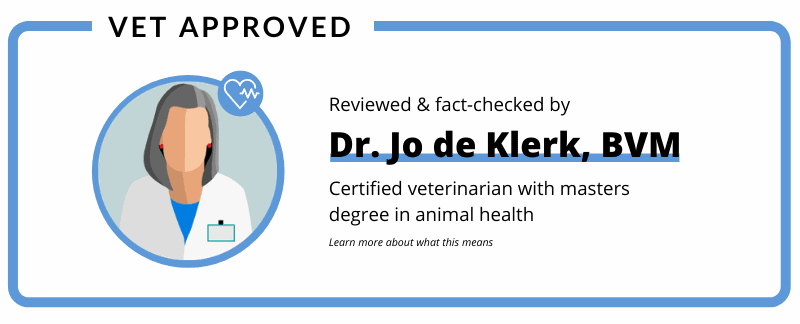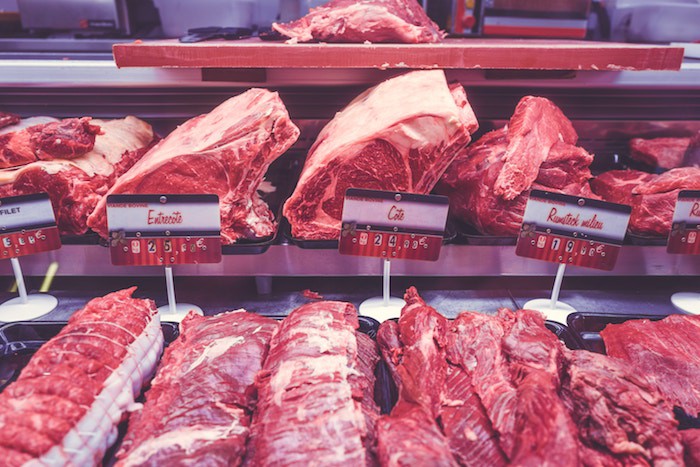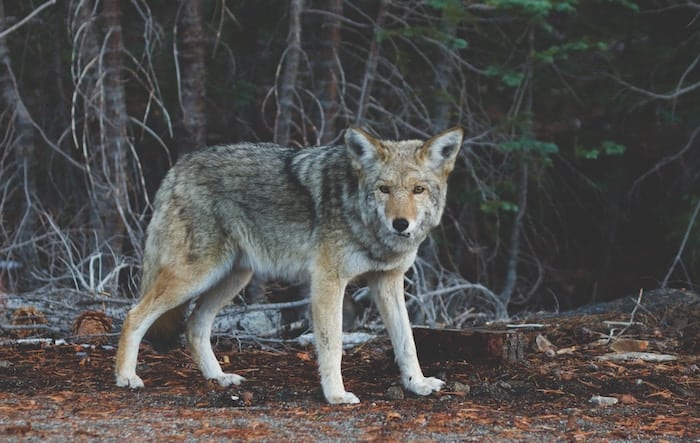Ate a Small Amount of Raw Beef

It'southward impossible to predict whether your dog will go ill from eating raw meat.
All dogs are dissimilar, as are all samples of raw meat. Your pup may crunch up a raw craven wing and remain in perfect health, or he may contract a terrible – potentially lethal – disease.
No matter the outcome, feeding your domestic dog raw meat amounts to very high-stakes poker.
Raw meat admittedly presents more risk than cooked meat does (regardless of whether the cooked meat take the grade of commercial kibble or a habitation-prepared repast).
In that location is null controversial about this ; cooking kills many of the germs and pathogens nowadays in raw meat.
Raw meat only isn't reliably rubber for your dog. Read on to larn why, and what you should practice if your canis familiaris already ate some raw meat.
- Raw meat can make your dog very sick. This isn't the least fleck controversial — raw meats are frequently contaminated with pathogens that can brand your dog very ill.
- Bacterial contagion is the primary reason raw meats are dangerous for dogs. Some dogs manage to consume contaminated food without becoming ill, but others may become very sick afterward doing and then.
- It is a very bad thought to deliberately feed your dog raw meat. Dogs tin can likewise get sick from scavenging raw meat from the garbage, and then yous'll want to exist conscientious when preparing or disposing of uncooked meat.
Help! What If My Dog Already Ate Raw Meat?
We'll talk well-nigh the bug associated with deliberately feeding dogs raw meat in a moment, but beginning, we wanted to accept a moment to talk well-nigh what you lot should exercise if your canis familiaris has already eaten a slice of raw meat.
For example, your canis familiaris may take snatched a slice of raw meat y'all dropped while cooking, or she may have helped herself to something sitting on the kitchen counter.
Starting time of all, don't panic – particularly if your dog just ate a small amount of raw meat (although you should probably work on stopping your dog from jumping up on the counter).
There's a big difference between your dog eating a seize with teeth of raw beef and feeding your domestic dog raw meat on a day-in, twenty-four hour period-out basis. The slice she ate may not accept been covered in bacteria, so she could get lucky. If the piece does turn out to accept been contaminated, the fact that your dog only ate a small amount will likely reduce the chances that she'll go seriously ill.
Even if your canis familiaris ate a considerable quantity of raw meat (such every bit a whole chicken breast), you probably don't demand to race over to the vet. Just get your vet on the phone, explicate what happened, and follow the advice provided.
Don't induce airsickness or take whatever other drastic measures. Only be sure to sentinel her for signs of affliction and contact your vet again if she starts airsickness or experiencing astringent diarrhea.
Need Veterinary Assistance Fast?
Don't have easy access to a vet? You may want to consider getting help from JustAnswer — a service that provides instant virtual-conversation access to a certified vet online.
You can discuss the issue with them, and even share video or photos if need be. The online vet tin help you determine what your next steps should be.
While talking with your own vet — who understands the ins and outs of your dog'southward history — is probably ideal, JustAnswer is a good backup option.
Why Did People Start Feeding Dogs Raw Meat in the First Place?
Throughout most of our shared history, dogs have substantially eaten our scraps.
This is still the case today to an extent. Compare the ingredients list on a bag of dog food to those on a frozen dinner — they are fabricated of the same stuff, more or less.
Aboriginal people would toss literal scraps and unwanted portions of cooked meat and vegetable matter to the dogs lurking around the burn down.

When commercial dog foods became widespread, nigh people embraced the convenience and frequently superior nutrition they provided. Past the middle of the 20th century, commercial dog food became the mainstream diet for dogs.
Simply, in 2001, a veterinarian by the name of Ian Billinghurst published a book called "The Barf Diet."
Before y'all get the wrong thought, the book is non referring to, you know, actual barf (although our dogs would probably beloved it – we've all seen our precious pup yak something up and re-eat it before nosotros could clean it upwards).
BARF is an acronym that stands for:
- Biologically
- Appropriate
- Raw
- Food
Some contend that it stands for Bones and Raw Food, but the idea is generally the same.
The book purportedly embraces "evolutionary principles" and seeks to mimic the diet of wild canines and felines. Many people roughshod in love with this idea and started feeding their domestic dog things similar raw chicken wings and meat-covered bones for dinner (oftentimes along with fruits and vegetables).
Many dogs love the sense of taste of raw meat and tend to tolerate it well. Merely, as explained previously, raw meat is often contaminated with a variety of pathogens that tin can sicken your canis familiaris.
You could fifty-fifty current of air up at the emergency room if you aren't careful.
Virtually Government Concur: Raw Meat Is Potentially Dangerous
You don't take to accept my give-and-take for it: Well-nigh veterinarians and researchers eschew raw meat diets. In fact, the very kickoff judgement of the American Veterinarian Medical Clan's raw meat policy states:
"The AVMA discourages the feeding to cats and dogs of whatsoever brute-source protein that has not first been subjected to a process to eliminate pathogens considering of the risk of illness to cats and dogs every bit well as humans."
Enquire your own vet what he or she thinks of the raw diet, but exist prepared for a similar respond. In the meantime, consider what the FDA says about raw meat (spoiler alert: the article is titled "Get the Facts! Raw Pet Food Diets can exist Unsafe to You lot and Your Pet"):
"The study showed that, compared to other types of pet food tested, raw pet food was more than likely to be contaminated with disease-causing bacteria."
To investigate the safety of raw meat diets, the FDA sampled hundreds of pet foods, including kibbles for dogs and cats, dry food for exotic pets, hasty treats, and more.
The results were eye-opening.
Merely one in 860 cooked or dried foods (a batch of dry true cat kibble) was contaminated with either Listeria monocytogenes or bacteria from the genus Salmonella .
Past contrast, nearly 24% of raw pet foods was contaminated by one of the 2 leaner . Fifteen of the 196 raw nutrient samples tested positively for Salmonella bacteria, while 32 showed the presence of the Listeria species in question.

Your Canis familiaris Is Not a Wild Canine (and That's a Practiced Matter)
Part of the rationale behind feeding dogs raw meat is the desire to provide them with a "biologically appropriate" nutrition.
However, there are a couple of bug with this thought process.
- Your dog is a domestic animal who has been artificially selected to live alongside humans . Despite their similarities with wolves and their familial connections to them, dogs and wolves are very different animals. Wolves take spent the last 10,000 years or and then eating elk and deer; dogs have spent this time learning how to beg for table scraps. Their diets differ markedly.
- Wild canines live curt lives . Many family dogs alive for 10 years of more (and that's withal non long plenty, if yous inquire me!), simply the average lifespan of a wild wolf is nearly 6 to 8 years. The average lifespan of a feral dog is fifty-fifty shorter – most simply live 1 or 2 years when forced to live "in the wild."
- Wild wolves are ofttimes infected with pathogens and parasites . Many of these internal bugs come up from the uncooked prey wolves eat, and some of them can be mortiferous.
Plenty of wild dogs and wolves become sick past eating raw meat – some go over the illness easily enough, while others may pay the ultimate toll. But they do non have a pick in the matter; there aren't many places a wild canine can get a cooked meal.

Pathogens Lurking in Raw Meat
The master reason that raw meat is dangerous involves the leaner and other microorganisms that may be present in nearly raw animal flesh.
These may not lead to symptoms in all dogs, simply information technology is wise to avoid the possibility entirely.
Salmonella
Salmonella is a genus of bacteria that can cause gastrointestinal illness and septicemia in humans. Virtually such infections are relatively minor and resolve afterward a few days, only some strains (called serotypes) tin can cause very serious illness or expiry.
Usually, Salmonella infections are of special business organization for very old, immature, or immunocompromised patients, only even otherwise salubrious adults occasionally require hospitalization.
And despite contentions to the reverse by raw-meat advocates, some Salmonella strains can as well affect dogs. It is truthful that most dogs simply carry the bacteria in their gut without developing any signs of illness. Notwithstanding, some dogs get quite sick and suffer from acute diarrhea for several days. Occasionally, even more severe symptoms manifest.
Additionally, even if your dog doesn't develop an disease from the bacteria, they surely spread infective spores nearly everywhere they go, potentially putting your family unit at chance.
Listeria
Listeria monocytogenes is a unsafe bacteria that causes disease in a wide variety of animals. Information technology ordinarily causes inflamed lesions in afflicted animals.
Although Listeria infections are relatively rare people, the 50% mortality charge per unit associated with the infection makes this a germ to avert.
Dogs tin carry and shed Listeria via their carrion and grooming habits, which can increase your chances of contracting the disease. Dogs tin become sick or die from Listeria, although this does appear to be quite rare.
Campylobacter
Campylobacter is a genus of bacteria that primarily causes illness in humans, but it besides afflicts dogs on rare occasions.
Unfortunately, every bit explained by VCA Hospitals, near clinical cases involve 1 of ii Campylobacter strains that are both resistant to antibiotics.
Most humans contract Campylobacter by eating undercooked poultry, merely people occasionally catch the illness from the bacteria excreted by their canis familiaris. It'southward not yet articulate how oft this occurs, but it is best to err on the side of caution.
Clostridium
Bacteria of the genus Clostridium, particularly Clostridium perfringens, tin cause severe diarrheal illness in dogs.
Many dogs carry the bacteria asymptomatically, just others become gravely ill. About ane-third of dogs with diarrhea exam positive for Clostridium, but many otherwise healthy dogs exam positive besides.
Researchers do non fully understand what makes some strains of the bacteria dangerous while others are plainly harmless. It is clear that many strains can cause serious affliction in humans, so it is wise to avoid giving your dog food contaminated with this bacteria.
E. Coli
Escherichia coli – oft abbreviated every bit E. coli — is a bacteria that lives in the large intestine of nearly mammals, including dogs and humans.
The vast majority of the bacterial strains are harmless, fifty-fifty important, components of normal abdominal flora. However, a few strains are capable of causing severe, acute affliction – particularly in young puppies.
Diarrhea is the well-nigh common symptom, but vomiting and cramping tin can as well occur, as can aridity from fluid loss. Those with weak immune systems may develop kidney failure in response to the bacteria.
Trichinosis
Pigs are often infected with pork worm ( Trichinella spiralis ) – a microscopic roundworm that causes affliction in people or dogs who consume undercooked or raw pork. These worms penetrate the muscles of infected animals, causing gastrointestinal illness, muscle pain, and other symptoms. The worms can persist for years in humans, and information technology is occasionally fatal.
Salmon Poisoning
Many people are surprised that raw salmon tin can acquit parasitic flatworms. Afterwards all, it is a staple in most sushi restaurants.
Don't worry; salmon — fifty-fifty raw salmon — remains condom for humans (and cats, bears, and nearly other carnivores) considering these particular parasites merely seem to cause issues for dogs.
Salmon and a number of their relatives ofttimes carry a parasitic flatworm called Nanophyetus salmincola. In most cases, this flatworm is relatively innocuous, causing few – if any – bug in animals who consume raw salmon. Simply these flatworms can themselves be infected with an organism called Neorickettsia helminthoeca, and this is what causes bug for dogs.
Typical problems include diarrhea, vomiting, inappetence, fever, and swollen lymph nodes. Without treatment, most dogs (90%) die from the infection.
As yous can see, at that place are a number of different pathogens that may lurk in a hunk of raw meat. Your dog may take been eating raw meat for years without ever getting sick, but each time y'all offer raw meat to him, you lot are rolling the dice with his health and yours.
If you actually desire to feed your dog raw, consider going with a manufactured kibble that includes chunks of raw freeze-dried morsels. These kinds of foods are becoming increasingly mutual, and they provide your dog with the yummy taste of raw nutrient while being somewhat safer, thank you to the freeze-drying process.
What do yous remember of feeding your dog raw meat? Have y'all ever considered information technology? Share your thoughts in the comments!
Source: https://www.k9ofmine.com/can-dog-get-sick-from-eating-raw-meat/